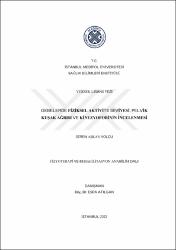| dc.contributor.advisor | Atılgan, Esra | |
| dc.contributor.author | Aşkar Yolcu, Seren | |
| dc.date.accessioned | 2023-11-01T09:58:23Z | |
| dc.date.available | 2023-11-01T09:58:23Z | |
| dc.date.issued | 2022 | en_US |
| dc.date.submitted | 2022-06-28 | |
| dc.identifier.citation | Aşkar Yolcu, S. (2022). Gebelerde fiziksel aktivite seviyesi, pelvik kuşak ağrısı ve kinezyofobinin incelenmesi. (Yayımlanmamış yüksek lisans tezi). İstanbul Medipol Üniversitesi Sağlık Bilimleri Enstitüsü, İstanbul. | en_US |
| dc.identifier.uri | https://tez.yok.gov.tr/UlusalTezMerkezi/tezSorguSonucYeni.jsp | |
| dc.identifier.uri | https://hdl.handle.net/20.500.12511/11683 | |
| dc.description.abstract | Çalışmadaki amacımız, gebelerde fiziksel aktivite seviyesi, pelvik kuşak ağrısı ve ki-nezyofobinin incelenmesi ve bu parametrelerin gebelerin farklı trimesterlerine göre dağılımını araştırmaktır. Çalışmaya, 18-49 yaş aralığında komplikasyonsuz gebeliğe sahip olan Türkçe okuyup anlayabilen, iletişim becerisine sahip, katılmayı kabul eden gönüllü hamile kadınlar anket çalışmasına dahil edilmiştir. Anketlerden önce gebelerin demografik bilgileri alınmıştır. Sonrasında fiziksel aktivite Gebelik Fiziksel Aktivite Anketi(GFAA) ile, pelvik kuşak ağrısı Pelvik Kuşak Anketi(PKA) ile, kinezyofobi Tampa Kinezyofobi Ölçeği(TKÖ) ve Kinezyofobi Nedenleri Ölçeği(KNÖ) ile gebeler bir defa değerlendirilmiştir. Çalışmada hata payı %5 olarak belirlenmiş ve analizlerin tamamı SPSS 26 programı kullanılarak yapılmıştır. Çalışmaya katılan gebelerin anket puanlarının istatistiksel analizi sonucunda, 3. trimester grubunda olan katılımcıların 1 ve 2. trimester grubunda olan katılımcılara göre PKA toplam ölçüm puanları daha yüksektir (p<0.05). Gebelerin beden kitle indeks değerleri incelendiğinde normal kilolu olan katılımcıların ve obez olan katılımcıların PKA, TKÖ, KNÖ ve GFAA anket puan-larının 1, 2 ve 3. trimester grubuna göre analizi sonucu PKA toplam ölçüm puanlarının 1, 2 ve 3. trimester gruplarına göre istatistiksel olarak anlamlı düzeyde bir farklılık bulunmaktadır (p<0.05). Obez olan 3. trimester grubundaki katılımcıların, 2. trimester grubunda olan katılımcılara göre PKA toplam ölçüm puanları daha yüksek olduğu görülmektedir. Ayrıca 2. trimester grubunda olan katılımcıların 1. trimester grubunda olan katılımcılara göre KNÖ toplam ölçüm puanları daha yüksektir. Çalışmamıza göre, gebelerin trimesterleri arttıkça pelvik kuşak ağrısının arttığı ve fiziksel aktivite seviyesinin değişmediği görülmüştür. Ayrıca 2. Trimesterdeki obez gebelerde hareket korkusu olduğu görülmüştür. | en_US |
| dc.description.abstract | Our aim in the study is to examine the physical activity level, pelvic girdle pain and kinesiophobia in pregnant women and to investigate the distribution of these parame-ters according to different trimesters of pregnant women. Volunteer pregnant women between the ages of 18-49, who had an uncomplicated pregnancy and who could read and understand Turkish and had communication skills, were included in the survey. Demographic information of the pregnant women was obtained before the question-naires.Afterwards, the physical activity was evaluated with the Pregnancy Physical Activity Questionnaire(PPAQ), the pelvic girdle pain with the Pelvic Girdle Question-naire(PGQ), the kinesiophobia The Tampa Scale of Kinesiophobia (TSK) and the Kine-siophobia Causes Scale (KCS) for once. In the study, the margin of error was deter-mined as 5% and all analyzes were made using the SPSS 26 program. As a result of the statistical analysis of the survey scores of the pregnant women who participated in the study, the total PGQ measurement scores of the participants in the 3rd trimester group were higher than the participants in the 1st and 2nd trimesters (p<0.05). When the body mass index values of the pregnant women were examined, as a result of the analysis of the PGQ, TSK, KCS and PPAQ questionnaire scores of the participants with normal weight and the obese participants according to the 1st, 2nd and 3rd trimester groups, the total PCA measurement scores were statistically significant compared to the 1st, 2nd and 3rd trimester groups. There is a difference in level (p<0.05). It is seen that the participants in the 3rd trimester group who are obese have higher PGQ total measure-ment scores than the participants in the 2nd trimester group. In addition, the partici-pants in the 2nd trimester group had higher KCS total measurement scores than the participants in the 1st trimester. According to our study, it was observed that as the trimesters of pregnant women increased, pelvic girdle pain increased and the level of physical activity did not change. In addition, it was observed that there was a fear of movement in obese pregnant women in the 2nd trimester. | en_US |
| dc.language.iso | tur | en_US |
| dc.publisher | İstanbul Medipol Üniversitesi, Sağlık Bilimleri Enstitüsü | en_US |
| dc.rights | info:eu-repo/semantics/openAccess | en_US |
| dc.subject | Fiziksel Aktivite | en_US |
| dc.subject | Gebelik | en_US |
| dc.subject | Kinezyofobi | en_US |
| dc.subject | Pelvik Kuşak Ağrısı Trimester | en_US |
| dc.subject | Kinesiophobia | en_US |
| dc.subject | Pelvic Girdle Pain | en_US |
| dc.subject | Physical Activity | en_US |
| dc.subject | Pregnancy | en_US |
| dc.subject | Trimester | en_US |
| dc.title | Gebelerde fiziksel aktivite seviyesi, pelvik kuşak ağrısı ve kinezyofobinin incelenmesi | en_US |
| dc.title.alternative | Examination of physical activity level, pelvic girdle pain and kinesiophobia in pregnancy | en_US |
| dc.type | masterThesis | en_US |
| dc.department | İstanbul Medipol Üniversitesi, Sağlık Bilimleri Enstitüsü, Fizyoterapi ve Rehabilitasyon Ana Bilim Dalı | en_US |
| dc.relation.publicationcategory | Tez | en_US |
| dc.institutionauthor | Aşkar Yolcu, Seren | |


















